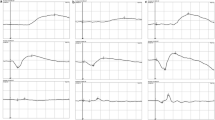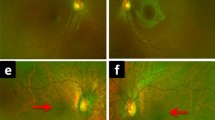Abstract
Purpose
To establish the normal range of values for rod-isolated b-wave amplitudes in achromatopsia and cone dystrophies.
Methods
We reviewed charts of 112 patients with various types of cone dystrophy, and compared their standardized electroretinographic rod b-wave amplitudes with age-matched normal controls. Twenty-six patients had known mutations in achromatopsia and cone dystrophy genes, while 53 were characterized by their inheritance pattern since they had yet to have their gene identified. Visual acuity information and scotomata were documented.
Results
We found that patients with achromatopsia and cone dystrophy had rod b-wave amplitudes that were significantly lower than age-matched controls, but found no evidence of rod amplitude progression nor loss of peripheral visual fields in the study group.
Conclusions
We found that cone dystrophy patients of all types had depressed rod-isolated ERGs across the board. If typical diagnostic criteria are used, these patients might be considered to have “abnormal” rod-isolated electroretinographic values, and might be called “cone-rod dystrophy”, even though the waveforms are stable for years. Patients with cone-rod dysfunction patterns on ERG can be better understood by also performing kinetic (Goldmann) visual fields, which will help to distinguish cone dystrophies from progressive cone-rod dystrophies by central scotomata size and progression over time in many forms of cone-rod dystrophy.


Similar content being viewed by others
References
Atmaca-Sonmez P, Khan KW, Heckenlively JR (2008) Hereditary cone dystrophies. In: Albert D, Jakobiec F (eds) Retina and vitreous. Saunders, Philadelphia, pp 2253–2259
Fishman GA, Sokol S (1990) Electrophysiologic testing in disorders of the retina, optic nerve, and visual pathway. American Academy of Ophthalmology, San Francisco, pp 60–64
Sadowski B, Zrenner E (1997) Cone and rod function in cone degenerations. Vision Res 37:2303–2314
Heckenlively JR, Arden GB (2006) Principles and practice of clinical electrophysiology of vision. MIT Press, Cambridge, pp 795–802
Khan NW, Wissinger B, Kohl S, Sieving PA (2007) CNGB3 achromatopsia with progressive loss of residual cone function and impaired rod-mediated function. Invest Ophathalmol Vis Sci 48:3864–3871
Wu H, Cowing JA, Michaelides M, Wilkie SE, Jeffery G, Jenkins SA, Mester V, Bird AC, RObson AG, Holder GE, Moore AT, Hunt DM, Webster AR (2006) Mutations in the gene KCNV2 encoding a voltage-gated potassium channel subunit cause cone dystrophy with supernormal rod electroretinogram in humans. Am J Hum Genet 79:574–579
Ben Salah S, Kamei S, Senechal A, Lopez S, Bazalgette C, Bazalgette C, Eliaou CM, Zanionghi X, Hamel CP (2008) Novel KCNV2 mutations in cone dystrophy with supernormal rod electroretinogram. Am J Ophthalmol 145:1099–1106
Thiagalingam S, McGee TL, Weleber RG, Sandberg MA, Trzupek KM, Berson EL, Dryja TP (2007) Novel mutations in the KCNV2 gene in patients with cone dystrophy and a supernormal rod electroretinogram. Ophthalmic Genet 28:135–142
Johnson S, Michaelides M, Alilgianis IA, Ainsworth JR, Mollon JD, Maher ER, Moore AT, Hunt DM (2004) Achromatopsia caused by novel mutations in both CNGA3 and CNGB3. J Med Genet 41:e20
Reuter P, Koeppen K, Ladewig T, Kohl S, Baumann B, Wissinger B (2008) Mutations in CNGA3 impair trafficking or function of cone cyclic nucleotide-gated channels, resulting in achromatopsia. Hum Mutat 2008(29):1228–1236
Xu J, Morris LM, Michalakis S, Biel M, Fliesler SJ, Sherry DM, Ding XQ (2012) CNGA3 deficiency affects cone synaptic terminal structure and function and leads to secondary rod dysfunction and degeneration. Invest Ophthalmol Vis Sci 53(3):1117–1129
Frumkes TE (1991) Suppressive Rod-cone interaction. In: Heckenlively JR, Arden GB (eds) Principles and practice of clinical electrophysiology of vision. Mosby Year Book, St. Louis, pp 469–474
Author information
Authors and Affiliations
Corresponding author
Rights and permissions
About this article
Cite this article
Wang, I., Khan, N.W., Branham, K. et al. Establishing baseline rod electroretinogram values in achromatopsia and cone dystrophy. Doc Ophthalmol 125, 229–233 (2012). https://doi.org/10.1007/s10633-012-9350-1
Received:
Accepted:
Published:
Issue Date:
DOI: https://doi.org/10.1007/s10633-012-9350-1




